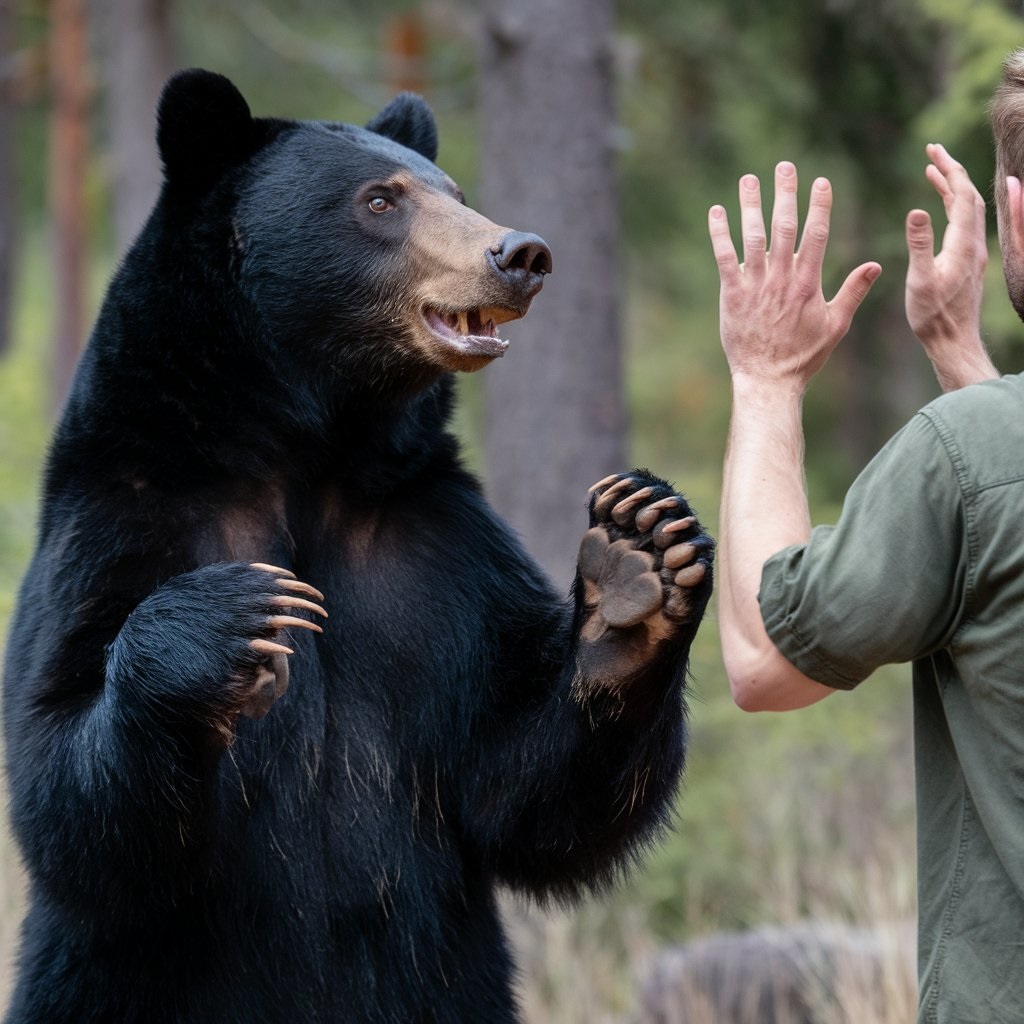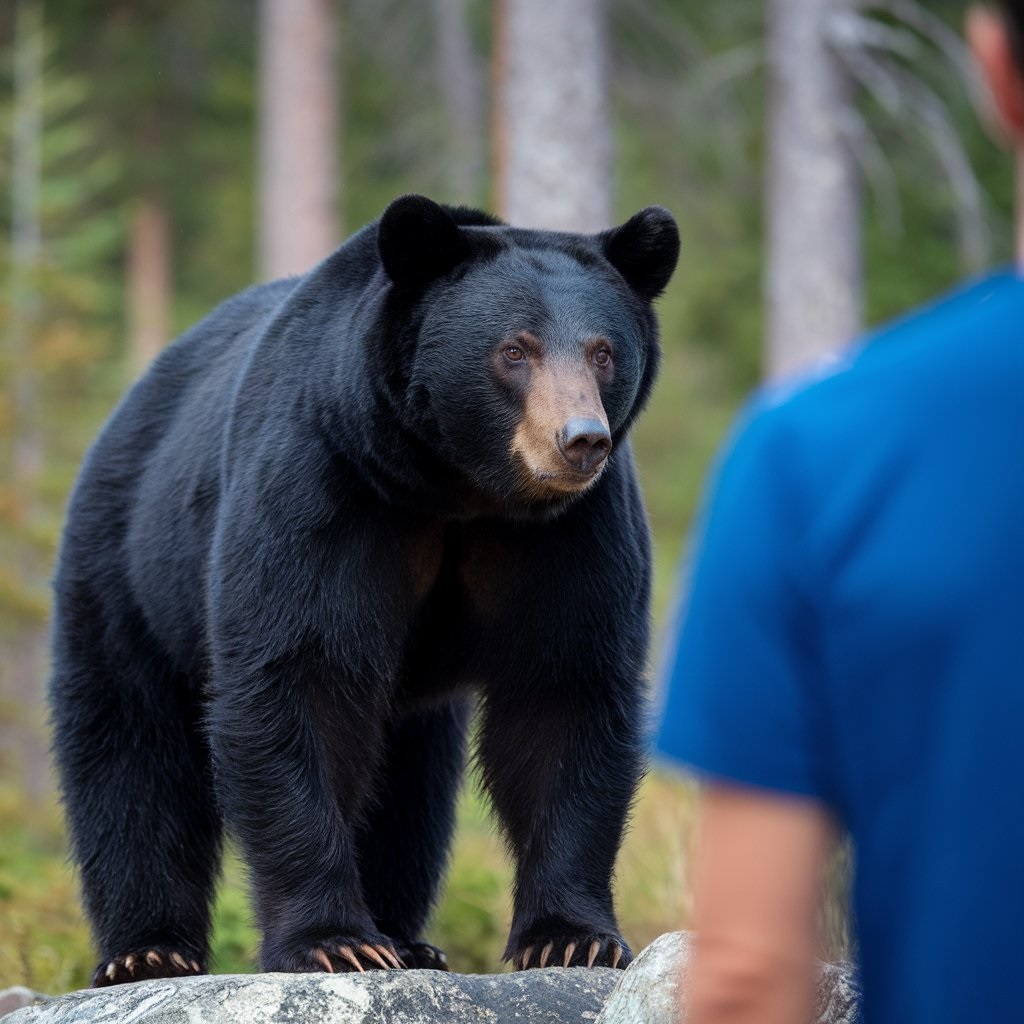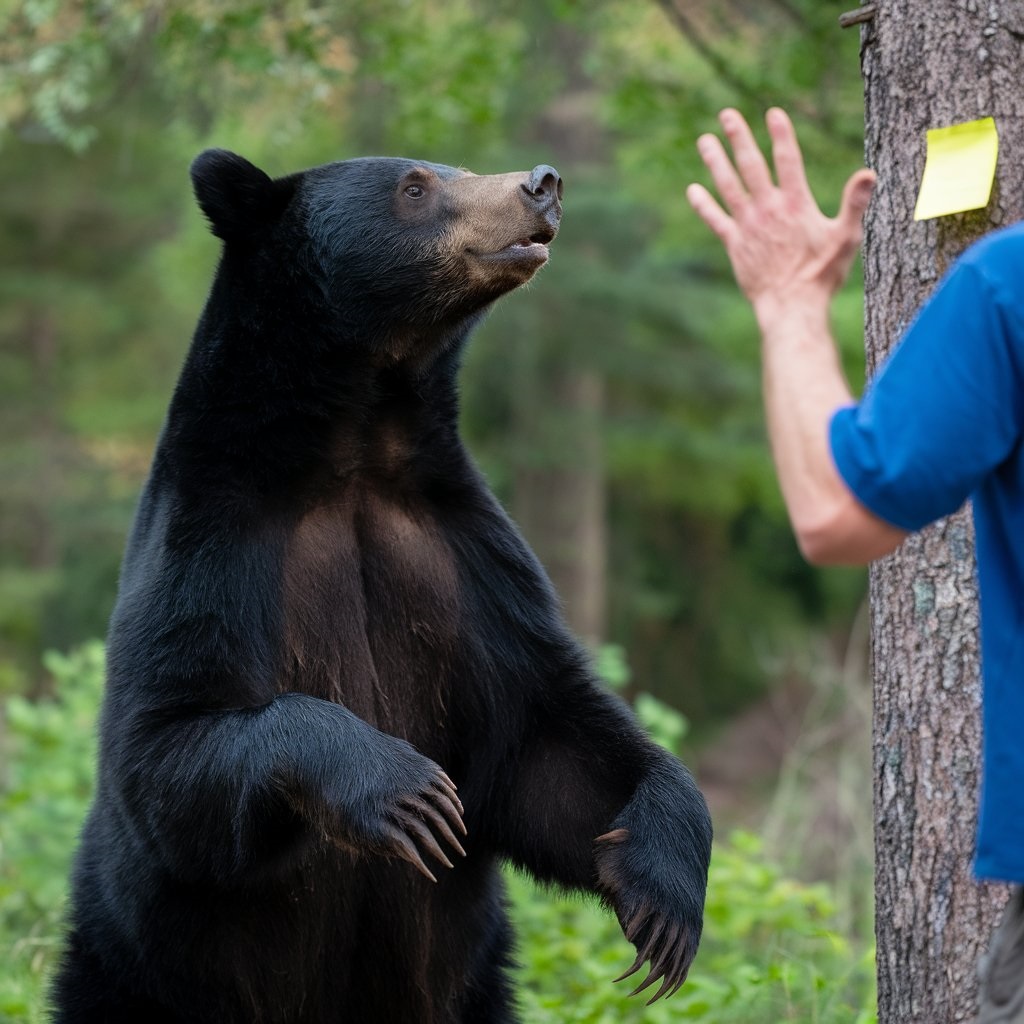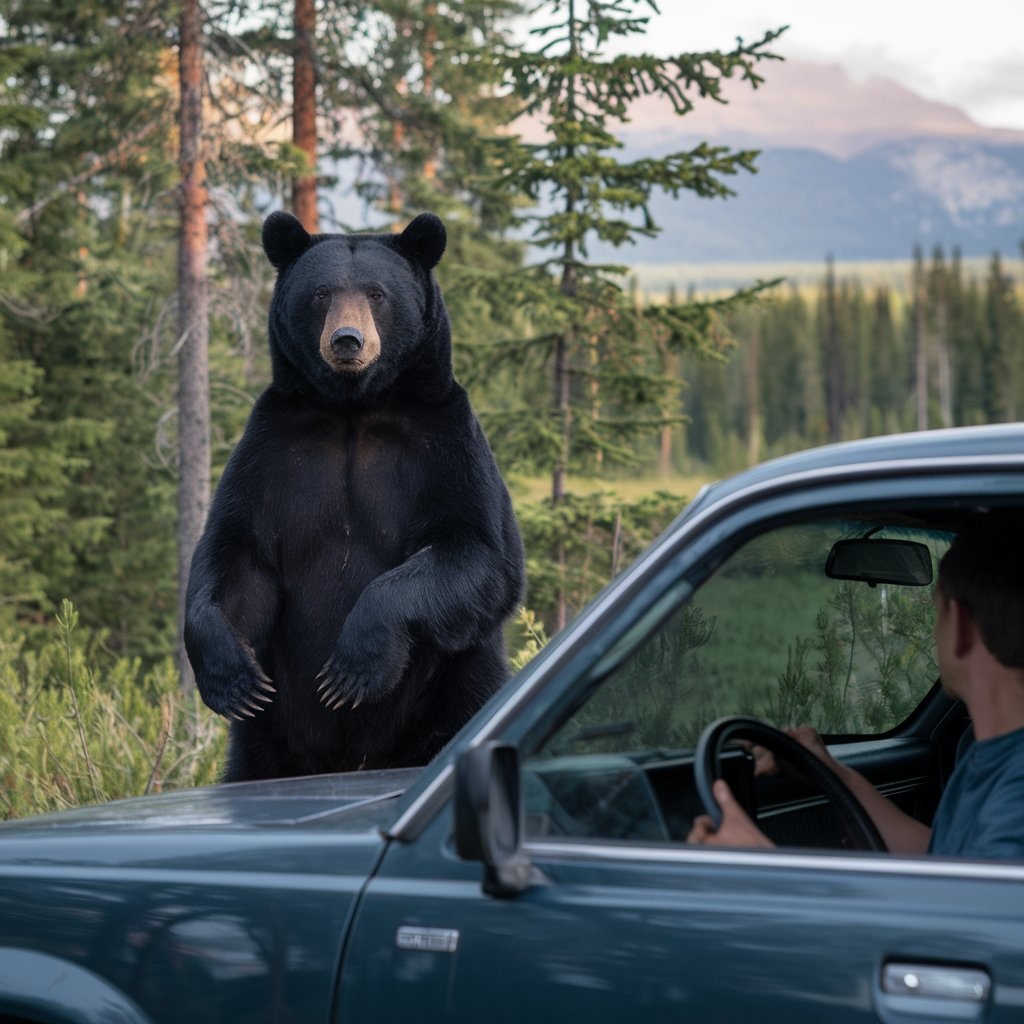Do Black Bears Attack Humans? This question stirs both fear and curiosity among those who enjoy exploring the great outdoors. While black bears (Ursus americanus) are generally shy and non-aggressive, attacks on humans, though rare, do happen under certain conditions. These encounters often spark debates about bear behavior, safety precautions, and the role humans play in these interactions. By understanding the truth behind these incidents and the factors that provoke them, we can coexist with these magnificent creatures more safely and responsibly.
While black bears (Ursus americanus) are typically shy and avoid humans, attacks do happen, often under specific conditions. In this guide, we’ll explore the truth about black bear behavior, the rare circumstances that lead to attacks, and how to prevent and respond to these encounters. Whether you’re a hiker, camper, or nature lover, this article will arm you with essential knowledge to stay safe in bear country.
Here’s a detailed table summarizing key facts and figures about black bears and their interactions with humans:
| Category | Fact/Figure | Details |
|---|---|---|
| Scientific Name | Ursus americanus | The most widespread bear species in North America. |
| Average Size | 100–300 lbs (female), 200–600 lbs (male) | Males are significantly larger than females. |
| Average Lifespan | 20–25 years in the wild | Lifespan decreases in areas with frequent human interactions. |
| Diet Composition | ~80% plants, ~10% insects, ~10% meat | Omnivorous diet varies based on availability of food sources. |
| Population | Approximately 800,000 across North America | Populations are stable, with some regions experiencing growth. |
| Range | Found in 40 of the 50 US states, most of Canada, and parts of Mexico | Thrive in diverse habitats, including forests, mountains, swamps, and suburban areas. |
| Fatal Black Bear Attacks | Fewer than 80 in North America over the last 100 years | Fatal attacks are extremely rare compared to other wildlife threats. |
| Non-Fatal Encounters | Approximately 1,000 annually in the US | Most involve food-conditioned bears or surprise encounters. |
| Top States for Sightings | Alaska, Montana, California, North Carolina, and Maine | These areas have large black bear populations and ideal habitats. |
| Speed | Up to 35 mph (56 km/h) | Black bears can outrun the fastest human sprinters. |
| Climbing Ability | Excellent tree climbers | Can scale trees quickly, often to escape predators or access food. |
| Hibernation Period | 4–7 months (varies by region) | Occurs in dens; metabolism slows to conserve energy. |
| Defensive Attacks | Most common type of attack | Usually involve mothers protecting cubs or bears feeling threatened. |
| Predatory Attacks | Rare but more dangerous | Often carried out by lone male bears during food scarcity. |
| Bear Spray Success Rate | ~92% in deterring bear attacks | Non-lethal and effective; considered the best defense tool. |
| Peak Bear Activity Times | Dawn and dusk | Avoid hiking during these hours to reduce the risk of encounters. |
| Economic Impact of Attacks | $5 million annually in the US (property damage, medical costs, prevention) | Includes costs associated with bear-proofing infrastructure and treating injuries. |
Who Are Black Bears?
A Closer Look at Black Bears
Black bears are the most common and adaptable bear species in North America, ranging across forests, mountains, swamps, and even suburban areas. Despite their name, black bears aren’t always black—they can be brown, cinnamon, or even blonde, depending on the region.
| Region | Color Variations |
|---|---|
| Pacific Northwest | Black, Brown |
| Eastern United States | Predominantly Black |
| Western States | Cinnamon, Blonde |
Unlike grizzly bears, which are larger and more aggressive, black bears tend to avoid confrontation. However, their remarkable intelligence, curiosity, and adaptability make them capable of behaviors that surprise even seasoned wildlife experts.

Black Bear Habitat and Range
Black bears occupy a staggering range of habitats, spanning the dense forests of Canada to the swamps of Florida. Their adaptability has allowed them to thrive in areas with diverse climates and ecosystems.
- Forests: Provide dense cover and abundant food sources.
- Mountainous Regions: Offer safety from predators and human interference.
- Suburban Areas: Bears are drawn by easy access to trash, pet food, and bird feeders.
- Wetlands and Swamps: Rich in vegetation, fish, and insects.
Fun Fact: Black bears have been spotted as far south as Mexico and as far north as Alaska!
What Do Black Bears Eat?
Black bears are omnivores, with diets influenced by seasonal availability. Here’s a breakdown of their typical diet:
| Food Category | Examples | Percentage of Diet |
|---|---|---|
| Plants and Fruits | Berries, acorns, grasses | ~80% |
| Insects | Ants, bees, termites | ~10% |
| Meat and Carrion | Small mammals, fish, deer | ~5-10% |
| Human Food | Trash, pet food, compost | Variable |
Do Black Bears Attack Humans?
Rare But Real: The Risk of Black Bear Attacks
The good news is that black bear attacks on humans are extremely rare. In fact, you’re more likely to be injured by a domestic dog or struck by lightning than attacked by a black bear. According to Dr. Stephen Herrero, a renowned bear expert, fewer than 80 fatal attacks by black bears have been recorded in North America over the last century.
However, this rarity shouldn’t lead to complacency. When black bears do attack, the consequences can be severe. Understanding the types of attacks and their triggers is crucial for staying safe.
Types of Black Bear Attacks
Defensive Attacks
Most black bear attacks fall into the defensive category. These occur when a bear feels threatened or cornered, such as when:
- A hiker inadvertently surprises a bear at close range.
- A mother bear perceives a threat to her cubs.
- A bear is protecting a food source.
Signs of Defensive Behavior:
- Huffing or loud exhalations.
- Popping sounds made by snapping jaws.
- Bluff charges, where the bear rushes forward but stops short.
How to Respond:
- Do not run. Running can trigger a chase instinct.
- Stay calm. Speak in a firm, low voice while backing away slowly.
- Make yourself appear larger. Raise your arms and stand tall.
Predatory Attacks
Far rarer and more dangerous are predatory attacks, where the bear sees a human as potential prey. Such behavior is typically exhibited by lone male bears, often during times of food scarcity or environmental stress.
Characteristics of Predatory Attacks:
- The bear approaches silently and deliberately.
- It lacks the defensive warning signals seen in other attacks.
- The bear doesn’t retreat when confronted.
How to Respond:
- Fight back aggressively. Use rocks, sticks, or any available tools.
- Aim for sensitive areas, such as the bear’s eyes and nose.
- Do not play dead. This strategy only works for defensive attacks.

What Triggers Black Bear Aggression?
Food Conditioning
Bears that become accustomed to human food lose their natural fear of people. This phenomenon, known as food conditioning, is a leading cause of dangerous encounters.
Examples of Food Conditioning:
- A bear regularly accessing trash bins in a suburban neighborhood.
- Campers leaving food unsecured in bear country.
- Wildlife photographers feeding bears to lure them closer.
Seasonal Behavior
Black bear behavior varies by season, influencing their likelihood of interacting with humans:
| Season | Behavior | Risk Level |
|---|---|---|
| Spring | Bears emerge from hibernation hungry and irritable. | Moderate |
| Summer | Mating season makes males more territorial and aggressive. | Elevated |
| Fall | Hyperphagia (intense feeding to prepare for hibernation). | High |
| Winter | Bears hibernate and are rarely active. | Low |
How to Prevent Black Bear Attacks
Tips for Avoiding Encounters
Preventing an encounter is far easier than surviving one. Here’s how to reduce your risk:
- Make Noise: Clap, sing, or talk loudly while hiking to alert bears to your presence.
- Travel in Groups: Larger groups are less likely to be approached by bears.
- Secure Food: Use bear-proof containers or hang food at least 10 feet off the ground.
- Keep a Clean Campsite: Dispose of trash properly and avoid leaving scented items out.
- Hike During Daylight: Bears are most active at dawn and dusk.
Responding to an Encounter
If you encounter a bear, how you respond depends on its behavior:
- Stay Calm: Avoid sudden movements.
- Back Away Slowly: Never turn your back or run.
- Make Yourself Look Bigger: Stand tall, raise your arms, and use a firm voice.
- Use Bear Spray: This is your most effective defense if the bear approaches.
Bear Spray: Your Best Defense
Bear spray is a non-lethal deterrent that can stop a bear in its tracks. Here’s how to use it effectively:
| Step | Action |
|---|---|
| Carrying | Keep the spray in an easily accessible holster. |
| Deploying | Aim slightly downward to create a fog barrier. |
| Distance | Spray when the bear is 20-30 feet away. |
Pro Tip: Always practice using bear spray before venturing into bear country.
Myths About Black Bears
Let’s debunk some common misconceptions about black bears:
- “Bears Only Attack When Provoked.” While true in most cases, predatory attacks can happen without warning.
- “Climbing a Tree Will Save You.” Black bears are excellent climbers and can easily follow you.
- “Playing Dead Always Works.” Playing dead is only effective during defensive attacks, not predatory ones.

FAQs
1. What are the chances of a black bear attacking a human?
The odds of being attacked by a black bear are incredibly low—about 1 in 2.1 million. You’re far more likely to be hurt by a bee or another person.
2. Can you fight off a black bear?
While rare, some people have successfully fended off black bears using tools, strength, or determination. Avoiding such situations is always the safest option.
3. Which type of bear is most likely to attack humans?
Species like sloth bears, Asiatic black bears, and brown bears are more aggressive, while American black bears are typically timid.
4. Can a human outrun a black bear?
No, humans can’t outrun black bears, which can reach speeds of 35 mph. Running may provoke the bear to chase you.
5. Why shouldn’t you play dead with a black bear?
Playing dead with a black bear is dangerous because such attacks might indicate predatory behavior, requiring you to fight back instead.
6. Can a human survive a black bear attack?
Yes, most black bear encounters are non-lethal, as these bears rarely attack unless provoked or startled.
7. How fast can a black bear run?
Black bears can sprint up to 35 mph, far exceeding the speed of even the fastest humans like Usain Bolt.
8. What are the three key bear safety rules?
Remember: “If it’s black, fight back; if it’s brown, lie down; if it’s white, good night.”
9. Which bear has caused the most human deaths?
Black bears have caused more fatalities than brown bears, largely because they are more numerous, not necessarily more aggressive.
10. Can you scare off a black bear?
Yes, loud noises, waving your arms, and making yourself appear larger can often intimidate a black bear to retreat.
11. How can you tell if a black bear is stalking you?
If a bear follows, approaches repeatedly, or shows aggressive behavior near campsites, it may be stalking and viewing you as prey.
12. How big are black bears?
Male black bears weigh about 400 pounds, stand 3 feet tall on all fours, and reach 5-7 feet when upright.
13. Are black bears afraid of humans?
Most wild black bears are naturally wary of humans and tend to avoid encounters whenever possible.
14. Should you make eye contact with a black bear?
Avoid direct eye contact with a black bear, as it may interpret this as a challenge or threat.
15. What should you do if a black bear is chasing you?
Stand your ground and make yourself look larger by raising your arms or climbing a high spot. Shout loudly to intimidate the bear.
16. What does it mean if a black bear huffs at you?
Huffing is a sign that the bear feels threatened or scared. It’s often a warning to back off.
17. What do black bears eat?
Black bears primarily eat berries, fruit, sedges, insects, and occasionally fish, honey, or young deer. They may also scavenge human garbage.

Conclusion
Black bears are remarkable creatures, integral to North America’s ecosystems. By understanding their behavior and following proper safety measures, you can minimize risks and enjoy their presence from a safe distance.
Quick Recap:
- Avoid Encounters: Make noise, secure food, and hike in groups.
- Respond Wisely: Stay calm, back away, and use bear spray if necessary.
- Know the Signs: Recognize the difference between defensive and predatory behavior.
Respect and preparation are your best tools in bear country. With these insights, you can coexist peacefully with one of nature’s most adaptable predators while staying safe and informed.
Read more knowledgeable blogs on Flowy Magazine

James Clair is a passionate writer and researcher with a deep fascination for animal behavior and its intricate connection to human life. With a background in [relevant field of study, e.g., zoology, psychology, ethology], James has spent years studying the natural world, focusing on how animals’ actions and instincts impact human emotions, behavior, and society.
His expertise in [specific topics or regions of focus, e.g., canine psychology, animal communication, wildlife conservation] has led to numerous published works and collaborations with renowned researchers and institutions. Through his work at Flawy Magazine, James aims to bridge the gap between scientific research and public understanding, offering insightful, accessible articles that explore the complex relationship between humans and animals.
When he’s not writing, James enjoys [personal hobbies or interests, e.g., hiking in nature, volunteering at animal shelters, photography] and is an advocate for [cause or charity related to animals or conservation]. His mission is to inspire readers to see animals not just as companions or creatures of the wild, but as beings whose behavior holds valuable lessons for us all.









